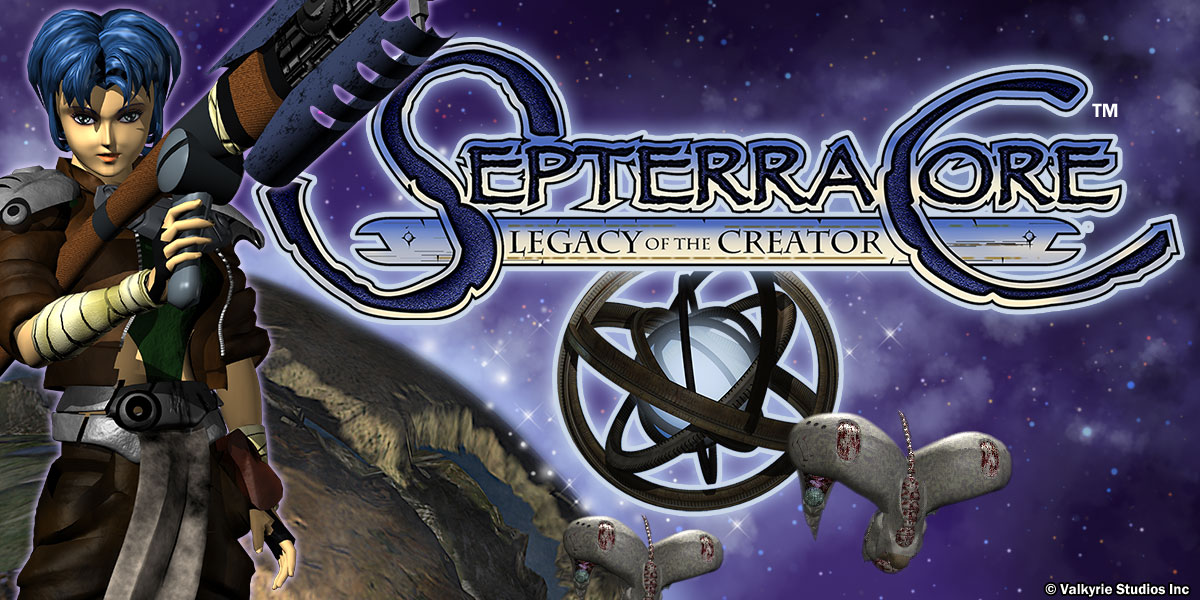Septerra Core: Legacy of the Creator marked its 20th anniversary since publication late in 2019. What follows is part 06 of a deep dive retrospective on the making of this cult classic RPG!
(BTW – In case you missed them, here’s Part 01, Part 02, Part 03, Part 04, & Part 05)
In 1997 we had successfully acquired the rights to Septerra Core from Viacom New Media (VNM), secured funding from a publisher, set up a brand new company in Valkyrie Studios, and began working on the game in earnest with a small team of dedicated developers.
Small Team, Big Ambitions
How small, you might ask?
The art team included only eight full-time artists: roughly broken down into three character modeler/animators, one full time animator, and four full-time background artists. Helping them out were two technical artists working on getting assets into the game.
On the programming side, we only had two full-time programmers: one crafting the game engine, and one on tools.
All told, with additional management, we had fifteen full-time people on the core team (pun intended).
And it all had to be done on a budget of less than $1.5 million USD.
To put these numbers into perspective, Final Fantasy VII (released in 1997, almost three years before Septerra Core) had a budget of $45 million USD with a development staff that varied between 100 to 150 people. FFVII was an outlier in the mid 90’s, a sea-change in development team size and budget, and most games didn’t have that kind of luxury. But Septerra Core’s budget was still only about one third the size of the more typical 1998 release, Baldur’s Gate ($4.5 million and about forty people).
Role playing games are massive titles, larger than anything anyone on the team had ever before worked on. We had a potentially hard climb ahead of us, but Valkyrie had a strong vision and a close-knit group of developers.
Everyone pulled double or triple duty, the artists often bouncing between modelling environments and characters, animation, graphics for the user interface, spell effects, cinematic movies, or even marketing and box art. Alisa, our head of art and scheduling, rolled up her sleeves to animate whenever she wasn’t running the day to day production. Meanwhile, I was just as busy. Back then we didn’t have narrative designers, combat designers, and other gameplay specialists. I was called on to handle most of the main design, handing off several chunks to others in the studio when I could (most notably combat AI scripting and UI), while also acting as art director.
And in order to allow such a small team to create such a big game, we had to work smart. Part of that was creating a robust tool set: TerraBuilder.
Power to the Artists

Game development in the ancient 90s was very different. Now-a-days, developers have the luxury of picking and choosing off-the-shelf tools to integrate into their game, from enemy behavior and scripting to sound and physics engines. These really didn’t exist yet, and most games had to be built from the ground up. That lack of tools meant the programming staff often became a bottleneck of development. Assets could be created far faster than the programmers could get them into the game engine, scrambling to take all that art and design and code it into the game in a manner close to the designer’s vision.
This bottleneck had long been a problem, and we had solved it while creating Beavis and Butt-head in Virtual Stupidity. Rather than hand off art and assets to a programmer, who would then have to work with the same artists to replicate their intentions, we built a tool that would put a great deal of that power (and responsibility) into the hands of the artists. Any artist could use it to make their own scenes, literally dragging and dropping characters, objects, and sound onto a background and animation timeline editor, all without ever having to rely on the programmer. It worked wonderfully, and led to truly hilarious and well-directed content.
Septerra Core needed the same treatment, plus more.
TerraBuilder was the answer, the tool we had started to develop back at VNM. It was designed to allow artists to layout backgrounds and add the invisible layer of data needed to interact with the characters, now it would expand to handle the editing of scenes and other gameplay elements, all that sweet, sweet data that was going to feed in to the game engine.
This put the power of creating content into the hands of the artists. Every time a player interacts with something in the world of Septerra, that scene that plays is the result of hours of work by an artist, moving characters, enemies, and even lip synching the dialogue, something that most games with “talking head” animation portraits never do, even to this day.
Overkill Engine!
But that’s not all! We also incorporated a logic scripting element into TerraBuilder that actually allowed designers and artists to script game logic, even if they had no programming experience.
We always knew that TerraBuilder would have that capability, but the way it was implemented actually came as a surprise. Most games back then (and even now) expect artists and designers to learn to script logic and events in a game through simplified code. But Roger, the programmer who was spearheading TerraBuilder, had a different idea, and that idea involved giant robotic mecha!

Back at VNM, Roger and I had gotten into a PSOne game called Carnage Heart (1995), a game about robotic, walking tanks. But instead of piloting these “Overkill Engines,” the player instead programmed them, creating a complex AI through a simple, grid-based flowchart. Only then did they release them against the enemy to see what happens.

Roger declared that his metal minions could obliterate my mechanical monsters—after all, he was a programmer, and he worked hard to ensure that his AI was as efficient as possible, making them fast and nimble on the hunt. I, on the other hand, had crafted my killer clankers to favor tactics like flanking maneuvers. What followed was the ultimate battle royale between efficient Programming and strategic Game Design! It was a huge showdown, where people from all across the company couldn’t care less about these two guys playing some obscure Japanese game—but we didn’t care, amping up the trash talk for days before the big throw down.
In the end, I took the trophy, two matches out of three, and I would never let Roger live it down.
But! Roger decided that instead of asking artists to write simple code, which would be prone to errors and misspelled commands, he would take a cue from Carnage Heart, and re-create their visual programming grid.
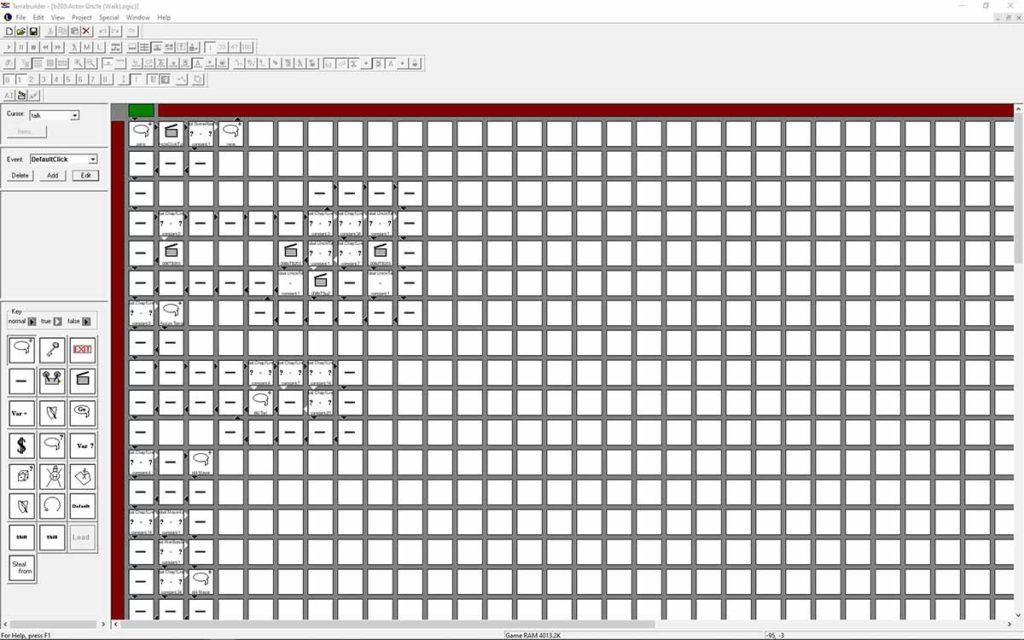
Suddenly, we had a tool that allowed any artist or designer to code (nearly) error-free logic. All of the dungeon logic in the game (opening and closing doors, picking up keys, etc) was scripted in TerrraBuilder by a few of the artists, in just a few days. All of the story logic—the logic that determines where the player is in the story, what NPCs are in what towns, the state of the politics, the state of the shops, the state of the overall plot, and the status of all side quests—was scripted mostly by me, with a little help from a few others .
That power of logic scripting in the hands of the artists meant they also got to flex their game design experience by also generating enemy AI, setting up gameplay and story logic, creating combat encounters, and crafting boss fight progression.
And all their work meant that Jim, our engine programmer, didn’t need to worry about hooking up content, but could instead focus on the actual game engine, making it run smoother, adding support for effects, integrating the sound engine from an outside developer, hammering out the massive complexity of combat, and coding the player character progression.
Clandestine Creativity
In fact, one day I was minding my business working in TerraBuilder when one of the artists came to me to ask for my opinion on something.
Jarod had taken on the task of enemy and boss AI scripting, and he wanted to get permission to add a secret to the game: what if there was a strange tower the player would find early on, but would remain locked? And what if there were strange little birds scattered around Septerra, and every time the player found one, it would fly away and later appear at the tower? And what if after the player found all the birds, it unlocked the tower, and the player could go inside and get a special reward?
I thought it sounded like a fun idea, but would we have the time so late in development to add a complex secret?
Jarod smiled sheepishly and then asked, what if it’s all already in the game, and all the logic scripting already works? And lo and behold, it was! Ask for forgiveness, not permission, I guess.
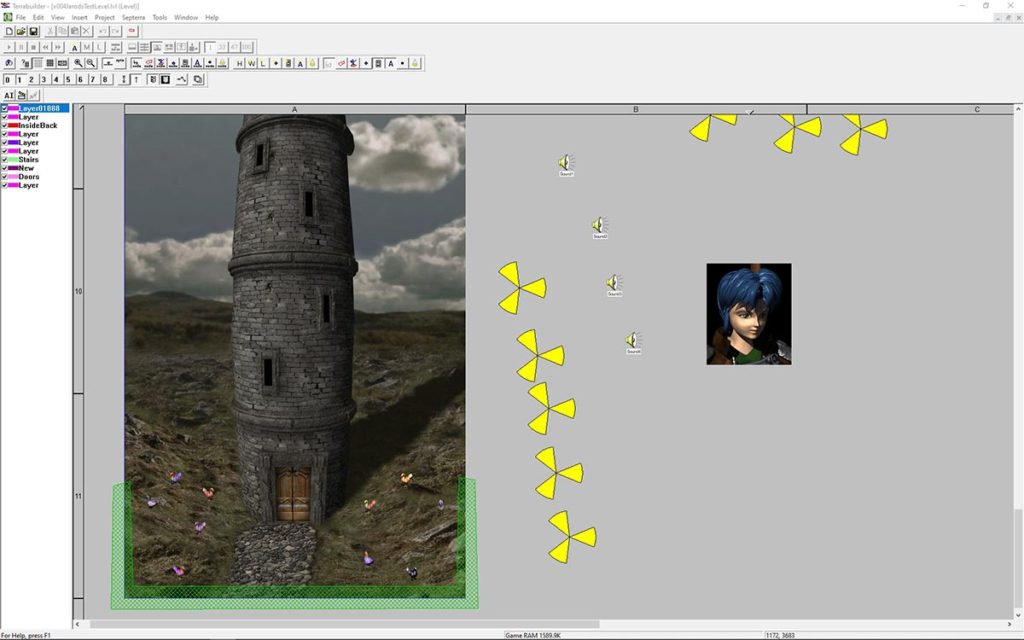
But that’s what the tools allowed the artists to do, all but bypass the programmers and add content straight into the game. In fact, a couple artists (Chip, Keith, and Jarod) had the bright idea to add books to the library of Wind City—why not let the player interact with those shelves to learn something about the backstory of the creatures, gods, and demons of Septerra? They not only had a fun time adding the content, I told them to go ahead and write the mythology for those creatures and stories, to have fun with it.
And that’s what we did. We had a lot of fun at Valkyrie.
For a deep dive of Terrabuilder, check out the video below!
The Valkyrie Family
Valkyrie was made up of people that had worked together for many years at VNM. We were more family than co-workers, and pretty laid back: people were free to work the hours they preferred. We didn’t care if someone worked early in the morning and then knocked off at four, or came in at noon and worked late into the evening—so long as their work was getting done and approved by the leads.
“…we worked really hard to create an environment at Valkyrie that made little distinction between working at or working with or working for. It’s the only place I ever worked that, beyond any ‘interpersonal difficulties’ that might have arisen between a few individual people, had little to no ‘political bullshit’ happening. …I’d like to think that all of ‘management’ at the studio made every effort to give everyone an equal voice, and never let anyone feel as though they were not being heard. And to the best of our ability, we tried to take care of everyone, and make sure that whenever possible, we were all having a good time.”
-Cathi Court, President of Valkyrie Studios during production.
I don’t feel that anyone took advantage of that trust. In fact, some people worked more hours than we wanted them to, adding details, secrets, and new content, or going back to add polish, not because it was required, but because they wanted to. At one point, I discovered that one of the artists had taken it upon himself to work extra hours and entirely replace an environment. The original pirate haven of Scumm Town felt too similar to other towns, but in the interest of time and money I had approved it. Chip hadn’t worked on it, but spent his own personal time modelling an entirely new level to replace it, in secret. It was a massive improvement, and it helped ensure that more areas in the game had their own, unique look.
People went above and beyond, like you do for family.
Team photos. Select any to view larger, and tap again for more details.
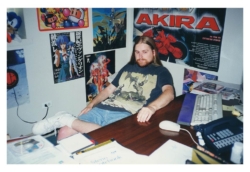

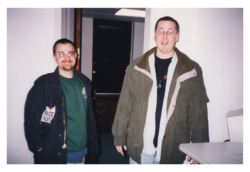
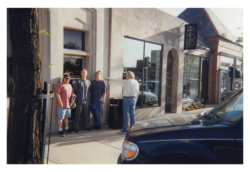



“Being in the industry for over 20 years, I have to say – there has never been such a perfect experience like there was working on Septerra Core at Valkyrie. It really was a “one for all and all for one” ideal. A really dedicated group that truly cared about the project – art/animators/programmers/mgmt were all just exceptional. It was fun, it was creative, it was challenging, it was the “best of times.” I’m very happy and proud to say I got to be a part of it.”
– Dave P, environmental artist
And being in the office was fun. We held regular events to break up the monotony of development.
Some of these were simple, like “Rib n’ Buffy” night, when we would stay late after work, order ribs, and watch the latest episode of Buffy the Vampire Slayer (on glorious 1997 VHS). There was always a pickup game of Armored Core and Bloody Roar. Halloween was always fun, but we needed more than one dress up holiday a year, so we invented “Evil Twin” day, where everyone was encouraged to come to work dressed as their evil doppelganger, or pajama day, when everyone came to work in their PJs like the office was one big slumber party.
Team photos. Select any to view larger, and tap again for more details.
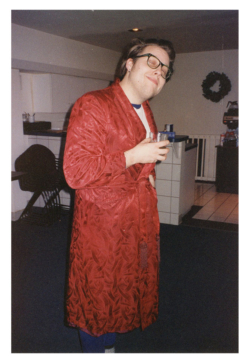

Fun, or an HR department’s worst nightmare?
Good thing we didn’t have an HR department—they probably would have quit with all the shenanigans that went on.
One day Roger’s parents came to visit. Roger’s dad was working part-time to program our sound engine, and he and the missus got a tour of the studio. Everything was fine until they visited the large office that three of the artists shared, all young lads with particularly dry senses of humor. That office had inherited furniture from the landlord, who, as a shipping magnate, had furnished the space with an 18th century nautical theme. There was a bench that pulled out into a bunk, and it had been affectionately dubbed the “buggery bed” in memory of all the seamen who surely found themselves lonely while sailing the high seas. Roger was excited to show his parents how it transformed.
It wasn’t until he did that one of the artists remembered what he had hidden in the bed as a joke: a handful of Playboys and a couple 40-ouncers.
Roger was not amused. Everyone else laughed (including his parents, if I recall).
The Secret Santa holiday party was equally dicey.
Jim’s present wasn’t elaborately wrapped—just a plain, brown paper bag. Inside he found a bevy of (very) adult men’s magazine and a bottle of equally hard liquor. Everyone laughed, and those magazines ended up in the men’s room.
I can’t imagine that happening today.
In hindsight, we were young, naïve, and pretty stupid. But, when people are friends for that many years, you understand their boundaries and you (hopefully) understand their sense of humor. The company was also run by two strong women, Cathi on the business side and Alisa on the production side, so hopefully that heavy dose of estrogen cancelled out the testosterone.
And the Valkyries really were friends. We hung out together at house parties—especially Cathi’s lake house on summer nights—we car-pooled to local comic cons, chipped in together on limos to check out concerts in style (Black Sabbath reunion!), and gathered to take in all the new late-90’s movies. For The Phantom Menace we gave some of the devs the afternoon off to go get tickets—i.e. stand in line all day to get tickets for everyone back at the office. At the midnight premier the theater ran a cosplay costume contest for cash prizes. The winner was to be determined by the audience’s cheers…
“As they announced it, Chip took off his shirt, wrapped it around his head and ran down to join the contest as “Rancor Keeper.” He tied for first place with (a fan dressed as) an amazingly accurate Darth Maul. It was freaking funny as hell but I always felt bad for that Darth Maul. Isn’t that always the way? You pour your heart and soul and spend countless hours making something perfect, and then some dude takes his shirt off and wraps it around his head and gets all the glory.”
-Jarod
Gus Almost Gets Shot
Gus was a technical artist (a “Terrabuilder”) on the project, building levels and data while also pulling double duty as our resident IT guy. He was a troublemaker in all the best ways, our resident daredevil—before parkour was a thing he was already finding ways to climb onto the roof of the office building, doing back flips off balconies at parties, dueling Jarod with foam lightsabers in the nearby park, or begging us to let him delve into the giant crack in the basement that surely must lead to an underground subterranean world of “mole men.”
And, oh yeah, Gus also almost got shot in the office.
We had given him permission to crash at the office while he was looking for a new place. Well, one night, Gus was there alone, sleeping in one of side offices, when lo and behold, he heard someone entering through the front door in the dead of night. Armed with a giant wrench we kept in the office in honor of Led, he creaked open his door to see several shapes moving in the dark with flashlights. Luckily he didn’t spring on these nefarious burglars, because it turned out they were cops. Gus had forgotten to lock the front door! When the cops discovered an unlocked office in the middle of the night they entered to make sure there wasn’t a robbery going down. How that man didn’t get shot, creeping out of a side office with a huge metal wrench is still a mystery.
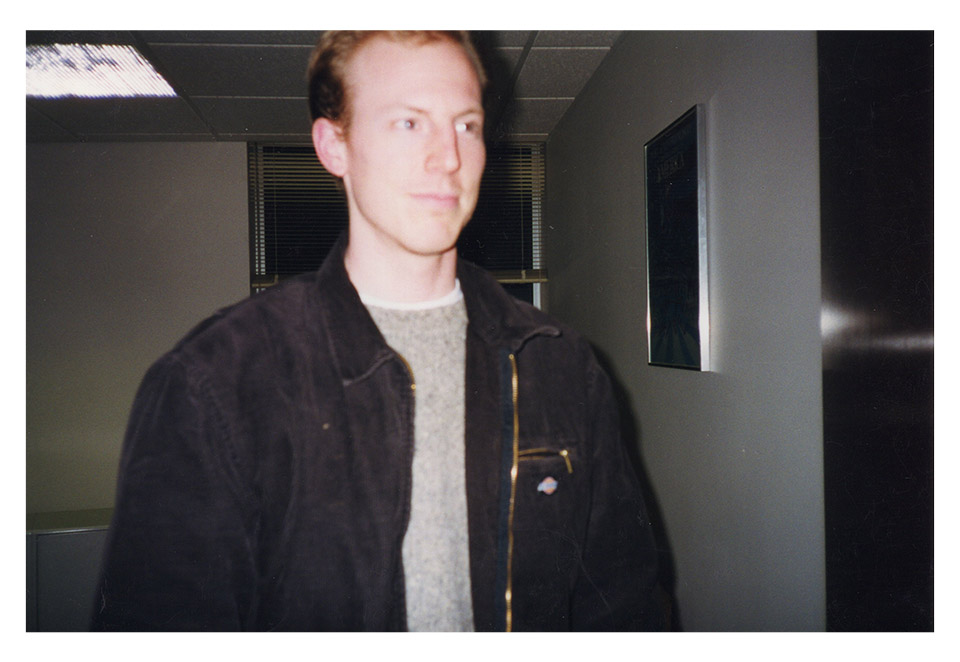
“THIS…. WAS SCARY!”
-Gus, still in shock 20 years later.
The Magnificent Bastard
Valkyrie had a mascot, of sorts, in Maggie, a mutt rescued off the mean streets of Chicago and looking for a home. Maggie visited Valkyrie in her search and nearly everyone immediately adored her. Gus and I set up obstacle courses for her with piled couch pillows and Maggie got a belly full of food. Cathi, our president, decided to adopt her, and I suggested a name: Magnificent Bastard the Mutt, or Maggie for short. Maggie visits were good days and she loved to run around and visit all the offices, especially Roger. Maggie loved him so much she would often get excited when she jumped up in his lap…and then accidentally pee on him…Oops.
Maggie photos! Select any to view larger, and tap again for more details.

The End (of development) is Nigh
It was an absolute pleasure to oversee such a talented team of creative and genuinely fun people. The solid bedrock of the work that had been done on the game back at VNM allowed us to hit the ground running, work hard, have fun, and make something we believed in.
Unfortunately, it wouldn’t last—the end of the project would see the team beset with an avalanche of bad luck and development woes, to say nothing of a few (very) bad decisions on my part.

